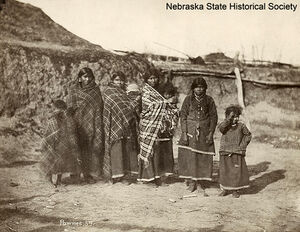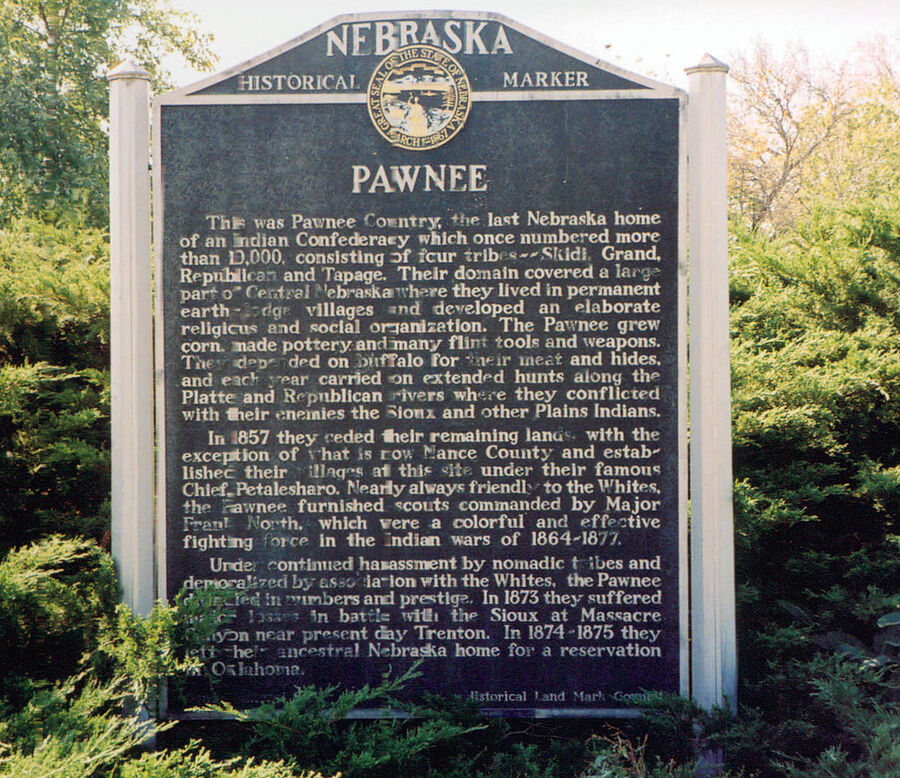
Here is a 1200-word article explaining the historical lands of the Pawnee Nation in Nebraska, suitable for a travel and historical education blog, direct and to the point.
>
Tracing the Pawnee Nation: Nebraska’s Deep Historical Heartbeat
Maps are more than mere geographical outlines; they are palimpsests, layers of human history etched onto the land. For the Pawnee Nation, the map of what is now Nebraska is not just a collection of rivers and plains, but a living testament to millennia of vibrant culture, profound spiritual connection, and an enduring struggle for survival. This article delves into the historical lands of the Pawnee, exploring how their identity was forged within Nebraska’s unique landscape, and how their legacy continues to resonate across the prairie.

The Original Heartland: A Landscape of Life
Long before the arrival of European explorers or American settlers, the Pawnee Nation thrived in the heart of the Great Plains, primarily along the Platte, Loup, and Republican River valleys in what would become Nebraska. This was their ancestral homeland, a territory that stretched roughly from the Niobrara River in the north to the Kansas River in the south, and from the Missouri River in the east to the High Plains in the west. This vast expanse, characterized by fertile river bottoms, expansive grasslands, and abundant wildlife, provided everything necessary for their sophisticated semi-sedentary lifestyle.
The Pawnee were not nomadic in the way some Plains tribes were. They were an agricultural people, skilled farmers who cultivated extensive fields of corn (maize), beans, squash, and pumpkins. Their substantial, dome-shaped earth lodges, often gathered into large villages of several hundred structures, speak to their settled nature. These villages, typically located on high ground overlooking rivers, were meticulously constructed and occupied for years, sometimes decades, before being moved to allow the land to rejuvenate.
But the Pawnee were also formidable hunters. Twice a year, typically in summer and winter, the entire village would pack up and embark on communal buffalo hunts, ranging far into the plains to secure vital meat, hides, and bone for their survival. This duality – rooted in agriculture yet mobile for the hunt – defined their seasonal rhythms and economic structure.

Spiritually, the Pawnee possessed a rich and complex cosmology centered on the heavens. They were astute astronomers, believing their villages, ceremonies, and even their earth lodges were microcosms of the starry sky. Tirawahat, the supreme being, orchestrated the universe, and celestial bodies like the Morning Star and Evening Star played pivotal roles in their creation myths and rituals. This deep spiritual connection to the cosmos was inextricably linked to their connection to the land, seeing the earth as Mother, nourished by the sky. Their identity was, in essence, an embodiment of the Nebraska landscape and the vast, open sky above it.
The Pawnee Nation was historically comprised of four distinct, yet related, bands: the Chaui (Grand), Kitkehahki (Republican), Pitahawirata (Tappage), and Skidi (Wolf). Each band maintained its own villages and traditions, though they shared a common Caddoan language and cultural heritage, often coming together for major ceremonies or defense. Their historical lands were not static, but fluid, shifting with environmental changes, inter-tribal relations, and the demands of subsistence.
The Inexorable March of Change: European Encounters and American Expansion
The arrival of Europeans marked the beginning of profound and irreversible changes for the Pawnee. Early encounters with French and Spanish explorers in the 17th and 18th centuries introduced new trade goods like horses and firearms, which initially augmented their existing culture, making hunting easier and warfare more impactful. However, these interactions also brought devastating diseases – smallpox, measles, cholera – against which the Pawnee had no immunity. Epidemics swept through their villages, decimating populations and weakening their social fabric.

The early 19th century brought a new and more dominant power: the United States. With the Louisiana Purchase in 1803, the U.S. claimed vast tracts of land, including Pawnee territory, without their consent or even full knowledge. The Lewis and Clark expedition, passing through the region in 1804-1806, recorded interactions with the Pawnee, noting their strength and significant presence. This marked the beginning of direct U.S. engagement, characterized by a relentless drive for westward expansion and the concept of "manifest destiny."
As American settlers pushed further west, the pressure on Native lands intensified. The Pawnee found themselves caught in a perilous squeeze. Not only were their traditional territories being encroached upon by settlers, but they also faced increased hostilities from neighboring Plains tribes, particularly the Sioux, Cheyenne, and Arapaho. These tribes, themselves displaced by American expansion from the east, were moving into Pawnee hunting grounds, leading to escalating conflicts over dwindling resources. The U.S. government, rather than protecting the Pawnee, often exacerbated these tensions, using them as a justification for further land cessions.
The Era of Treaties and Diminishment: A Map Rewritten
The 19th century for the Pawnee Nation became a story of progressive land loss through a series of treaties with the United States government. These agreements, often negotiated under duress and misunderstanding of land ownership concepts (where the U.S. viewed land as a commodity to be bought and sold, while the Pawnee viewed it as a sacred, shared inheritance), steadily shrank their ancestral domain.
- 1833 Treaty: This was the first major land cession, relinquishing lands south of the Platte River in exchange for annuities and goods. This treaty significantly reduced their southern hunting grounds.
- 1857 Treaty of Table Creek: This pivotal treaty saw the Pawnee cede almost all of their remaining lands in Nebraska, reserving only a small, rectangular tract along the Loup River for a reservation. This was a direct response to increasing settler pressure, inter-tribal warfare, and the U.S. government’s policy of consolidating tribes onto smaller reservations. The Pawnee, weakened by disease and constant conflict, saw this as their only viable option for survival, hoping for U.S. protection against their enemies. The reservation, near present-day Genoa, Nebraska, became their last foothold in their ancestral homeland.
- 1876 Agreement: Following further pressure and the failure of the U.S. government to adequately protect them on the reservation, the Pawnee were forced to "agree" to sell their reservation lands in Nebraska and remove to Indian Territory (present-day Oklahoma). This was the final act of dispossession, severing their direct physical tie to Nebraska.

Each treaty dramatically altered the map of Nebraska, erasing ancestral boundaries and replacing them with lines drawn by a foreign power. For the Pawnee, these lines represented not just lost acreage, but lost spiritual sites, hunting grounds, burial places, and the very foundation of their way of life.
Life on the Reservation and the Journey South: Resilience in Adversity
The period on the Loup River Reservation (1857-1876) was one of immense hardship. The Pawnee, accustomed to a life of agricultural plenty and vast hunting grounds, struggled to adapt to a confined existence. Annuities were often late or insufficient, disease continued to take a toll, and hostile raids from the Sioux and other tribes, often unchecked by the U.S. Army, were a constant threat. The infamous "Battle of Massacre Canyon" in 1873, where a large Pawnee hunting party was attacked by a much larger Sioux force, resulting in significant loss of life, underscored the U.S. government’s failure to protect them.
In a desperate bid for survival, many Pawnee men enlisted as "Pawnee Scouts" for the U.S. Army, serving as guides and soldiers against other Native American tribes, including those who were their traditional enemies. This complex and often tragic chapter highlights the impossible choices forced upon Native peoples, where survival sometimes meant fighting alongside their oppressors against their own kind.
Ultimately, the pressure became unbearable. The promise of peace and self-sufficiency on the reservation failed to materialize. Between 1874 and 1876, the majority of the Pawnee Nation made the difficult and heartbreaking journey south, walking away from their ancestral lands in Nebraska to a new reservation in Indian Territory. This forced removal, a common narrative among Native American tribes, represented the physical sundering of a people from their homeland.
The Enduring Identity: Beyond the Nebraska Borders
Despite the profound trauma of removal, the Pawnee Nation did not vanish. In Oklahoma, they rebuilt their communities, adapting to a new environment while fiercely holding onto their cultural identity. Oral traditions, language, ceremonies, and knowledge of their Nebraska homeland were meticulously preserved and passed down through generations.
Today, the Pawnee Nation of Oklahoma is a vibrant, self-governing tribe. They maintain their language, conduct traditional ceremonies, and actively work to repatriate ancestral artifacts and honor their history. While physically distant from Nebraska, their connection to their ancestral lands remains central to their identity. The stories of the Platte, Loup, and Republican Rivers, the vast buffalo grounds, and the sacred earth lodges are still told, ensuring that the spirit of their Nebraska homeland lives on.
Experiencing Pawnee History Today in Nebraska
For travelers and history enthusiasts in Nebraska, understanding the Pawnee story transforms the landscape. While there are no active Pawnee reservations in the state today, their presence is deeply embedded in the land and its historical records.
- Archeological Sites: Numerous archeological sites throughout Nebraska attest to Pawnee occupation, offering glimpses into their earth lodge villages and agricultural practices. While many are not publicly accessible, the Pawnee Indian Village State Historic Site in Kansas, just south of the Nebraska border, offers an exceptional interpretive experience, showcasing the remains of a 19th-century Skidi Pawnee village. This site provides a vivid understanding of the Pawnee lifestyle that once flourished across the border in Nebraska.
- Historical Markers and Museums: Throughout Nebraska, particularly along the Platte and Loup Rivers, historical markers commemorate significant Pawnee sites and events. Museums like the Nebraska State Historical Society Museum in Lincoln and the Stuhr Museum of the Prairie Pioneer in Grand Island house extensive collections of Pawnee artifacts, offering invaluable insights into their material culture, spiritual beliefs, and daily life. The Genoa Indian Industrial School Museum in Genoa, located on the former Pawnee Reservation, tells the story of that specific, challenging period.
- The Landscape Itself: Perhaps the most profound way to connect with Pawnee history is to simply experience the Nebraska landscape. Stand by the Platte or Loup River, gaze across the vast prairies, and imagine the thriving villages, the thundering buffalo herds, and the deep spiritual connection the Pawnee had with this land. The wind whispering through the tallgrass carries echoes of their past.
The story of the Pawnee Nation in Nebraska is one of immense resilience, deep cultural roots, and the enduring power of identity. It’s a reminder that maps tell complex stories, and that beneath the modern lines of states and counties lies a rich tapestry of indigenous history waiting to be understood and honored. By engaging with this history, we not only learn about the past but also gain a deeper appreciation for the profound human connection to place, and the living legacy of a people who once called Nebraska their sacred heartland.
